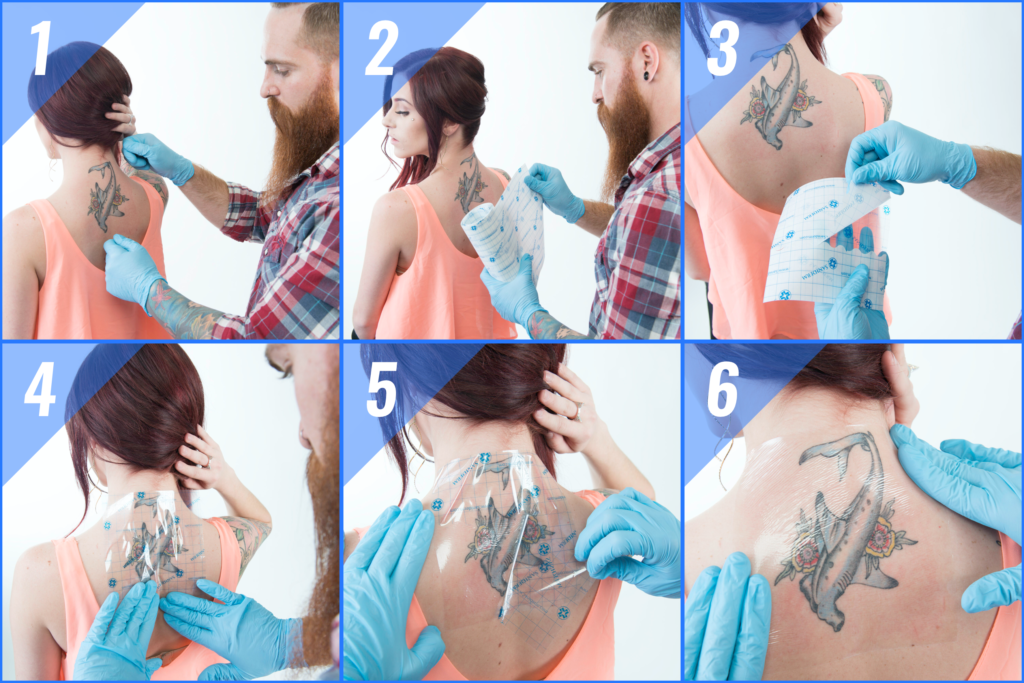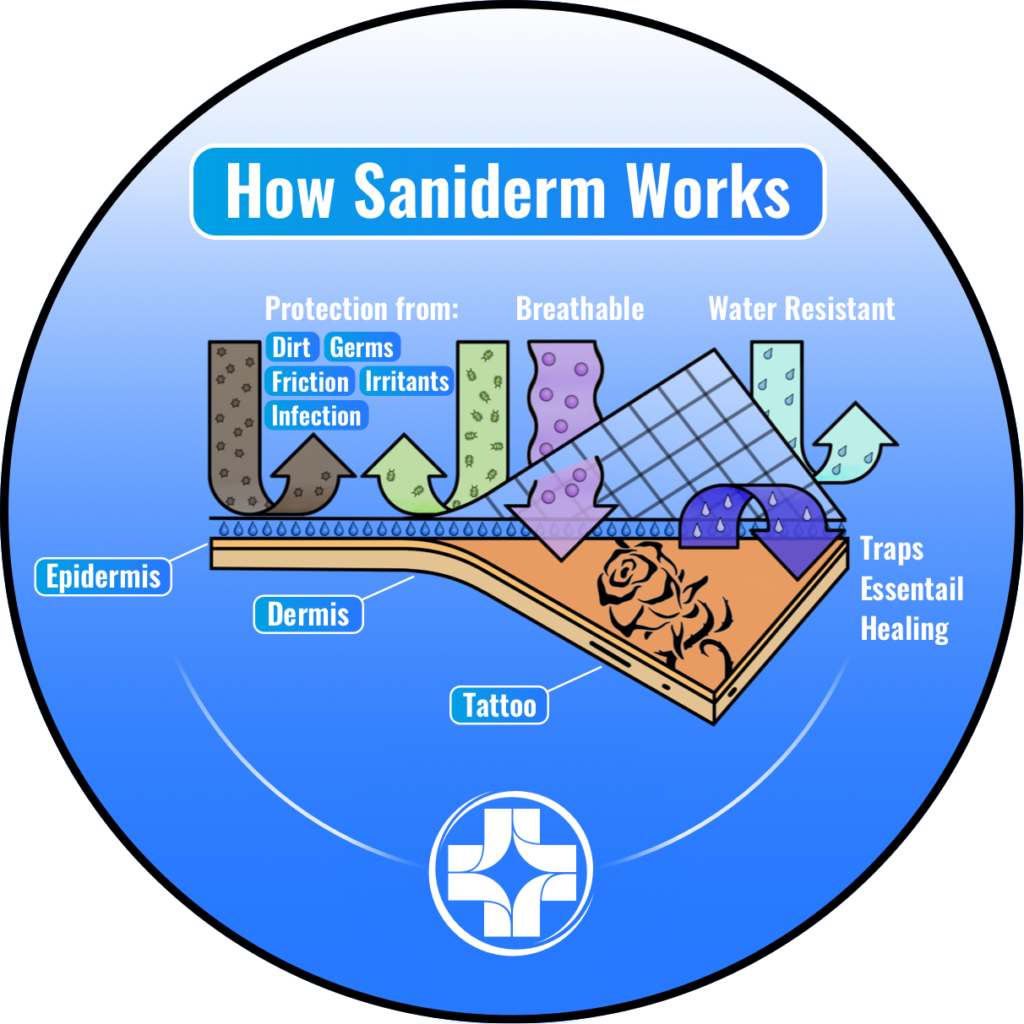How Does a Saniderm Tattoo Bandage Work?

Did you know that a tattoo is an open wound? As you get tattooed, your body undergoes a series of traumatizing punctures, which will create an abrasion-like wound. And, just like any wound, it opens your body up to the risk of infections. This is where a Saniderm tattoo bandage comes in.
What is Saniderm?
Saniderm is a medical-grade, waterproof tattoo bandage that is breathable and used like a “second skin” to heal your tattoo.
Before we begin discussing how Saniderm works, you first have to understand how tattoo healing works. Let’s take a quick look.
What is the Tattoo Process and Healing Process?
The art of tattooing is accomplished by the insertion of pigment into the skin’s dermis. This is traditionally done by rubbing the pigment into cuts.
A tattoo artist creates your art by puncturing your skin thousands of times at a rapid pace. This process creates a large area of vulnerable skin—an open wound. When you finish your tattoo session, your tattoo immediately enters the healing process.
The tattoo healing process, while similar to general wound healing, is its own unique progression. In fact, you can break it down into three stages. These stages can vary in length and severity by person—making it hard to really nail down exactly when and for how long your body will experience them.
What Are the Tattoo Healing Stages?
Stage 1
The first stage is essentially considered the open wound stage. This is the period of time in which your body is still trying to seal its open skin and when you are at the greatest risk of infection and complication.
Your body will try The first stage is essentially considered the open wound stage. This is the period of time in which your body is still trying to seal its open skin and when you are at the greatest risk of infection and complication.
When your tattoo is first completed, it will appear very bright and start to look discolored and dull during the healing process. Your tattoo will start to scab as well. It’s important to take care of your tattoo during this process so that it doesn’t begin to scar. Signs of scaring may include raised, puffy skin, redness that doesn’t fade, distorted colors within the tattoo, or pitted skin.
During the healing process, your body will try to seal its open wound by excreting a substance, called plasma, that will help this process. It is natural for our bodies to produce this healing element, which helps to break down dead tissue and rebuild new tissue.
Under normal circumstances, these healing elements would dry up or evaporate quickly, creating a scab. However, in tattoo healing, scabbing is detrimental to the design.
To avoid this, you keep the tattoo well-moisturized and covered with a tattoo bandage throughout the healing process. This keeps the skin from scabbing and allows the body to heal without creating a pesky shell that could potentially pull out the ink.
Stage 2
During the second stage of healing, the skin becomes tight and itchy. During this portion of the healing, the top layers of skin that were traumatized throughout the tattoo loosen and begin to lift off, giving the skin a peeling appearance.
It will essentially look like a peeling sunburn. Again, keeping it moisturized during this process can help ease the itching and protect the tattoo from any additional trauma caused from drying out.
Stage 3
The third stage of healing actually takes place below the skin after the open wound portion of the tattoo has closed up. At this point, the ink begins to settle into the layer of skin called the dermis. Your risk of infection has passed at this point in the healing, however, it is vital to keep the area well-moisturized to prevent any early blurring as the tattoo wraps up the final stage of healing.
How Does An Infected Tattoo Look?
The most common symptom associated with a tattoo infection is red, bumpy skin surrounding the tattoo. However, this may not always be associated with an infection. In some cases, your skin may just be irritated due to the needle. In which case, the rash should clear within a few days. Some other symptoms of a tattoo infection may include:
- A fever
- Shivering
- Swelling in the tattooed area
- Pus coming from the tattooed area
- Red lesions around the tattooed area
- Red streaking from the tattooed area
- Feelings of waves of heat and cold
- Raised tissue that feels hard

How Saniderm Works
Now, you’re probably wondering how Saniderm comes into play in this delicate healing process. It’s simple— Saniderm is a tattoo wrap that helps the healing process by protecting your tattoo from dirt, germs, and other bacteria from collecting on it and causing infection.
While your skin is in the first stage of healing, it is especially susceptible to infection from outside elements. This includes airborne bacteria, dirt, dust, pet dander, and environmental elements.
In many cases, you may not even be aware that you have been exposed to such factors. When applying a moisturizer to the tattoo, you create a tacky surface for these elements to stick to. Obviously, this heightens the risk of infection.
For this reason, many people turn to a tattoo bandage to help cover the skin and limit the risk of contamination. However, it is important to steer clear of household plastic wrap, as it does not allow the tattoo to breathe—a crucial part of the healing process! After all, plastic wrap is for leftovers, not tattoos!
Saniderm is Different

By design, Saniderm’s tattoo bandage is permeable enough for oxygen and water vapor to pass through. This is important, as it allows the wounded area to maintain optimal levels of breathability.
Additionally, Saniderm protects against dirt and germs, offering protection from friction and other irritants. No worries about your furry friend rubbing against your tattoo or trying to stop nosey people from rubbing their hands on it.
Saniderm works by locking in your body’s natural healing fluids so your tattoo stays hydrated and heals quickly and efficiently with no scabbing and reduced scarring. In addition, we engineered Saniderm to be gas permeable so your skin can breathe and get all the oxygen it needs to heal perfectly.
Another perk—because it is breathable, you can wear Saniderm for several days at a time while your tattoo heals. This allows you to skip out on the frequent washing and ointment applying involved with traditional tattoo aftercare.
Have additional questions about Saniderm? Want to know what we think are the best products to put on a new tattoo? Ask our tattoo aftercare knowledge base!

Exactly how long am I supposed to keep this type of bandage on?
Thanks for reaching out
The recommended instructions are to apply at the finish of the tattoo and leave on for 24 hours. This will fill up with plasma. At the 24 hour mark, remove and wash the tattoo. Once dry, apply a second piece that will stay on for up to 6 days for a total healing time of 7 days. If the tattoo weeps into the second piece of film, follow the above instructions at the next 24 hour period and apply a 3rd piece. The third piece would then stay on for 5 days.
Thank you,
Saniderm Support
Can I use the saniderm bandade be used on reef cuts or grazes, reef rash, gravel rash?
Saniderm can be used on cuts and scrapes. Always make sure the wound is cleaned prior to applying Saniderm.
Thank you,
Saniderm Support
Is it okay if I leave my first saniderm on for 7 days? I do not have a spare and the artist said leave it on for 7 days, if any air or water gets in remove it instantly.
Thanks for reaching out
The recommended instructions are to apply at the finish of the tattoo and leave it on for 24 hours. This will fill up with plasma. At the 24 hour mark, remove and wash the tattoo. Once dry, apply a second piece that will stay on for up to 6 days for a total healing time of 7 days. If the tattoo weeps into the second piece of film, follow the above instructions at the next 24 hour period and apply the 3rd piece. The third piece would then stay on for 5 days.
If there is no fluid in the bandage you are fine. If there is plasma in the bandage it needs to be changed or removed. When you remove the bandage you should continue with traditional tattoo aftercare procedures.
Thank you,
Saniderm Support
Is it normal for the saniderm to be tough to take off
Thanks for reaching out
Saniderm can be tough to take off sometimes. We recommend removing Saniderm under warm running water. If that does not help you can rub baby oil, coconut oil, or olive oil around the edges to help break up the adhesive.
Thank you,
Saniderm Support
My artist told me to leave it on til it Mayo came off- is this ok?
Til it naturally came off…
Hey Cindy!
As long as it’s not longer than 3-5 days and it’s not causing skin irritation then yes, that’s completely fine! Also glad to hear you didn’t have mayo on your tattoo.